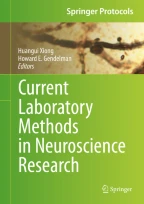
This chapter will summarize commonly used methods of brain tissue preparation, sectioning, and staining. History, development, and novel application of those methods in neuroscience will be presented herein so students can fully grasp the topic of brain tissue preparation, sectioning, and staining. The selectively introduced methods in this chapter are as follows: (1) Transcardial perfusion, especially on rats and mice, with a supplemental video referenced online to show perfusion procedure for adult rats. (2) Cryoprotection and frozen section cutting, with emphasis on the importance of cryoprotection for obtaining superior histological staining. Examples will be based on the author’s own experiences. (3) Paraffin embedding and sectioning, in which a general procedure is introduced. (4) Vibratome sectioning and application in histochemical staining for electron microscopy (EM) studies. In this chapter, procedures introduced will be based on cutting 50 μm sections for EM histochemical stains and plate embedding. We described detailed protocols for tissue treatment using freeze and thaw and ABC kit to reveal immunostain, two key steps in all immuno-EM. (5) Following histochemical staining, the stained structures need to be further observed under EM. These ultrathin sections are generally 1.5 mm long and 0.5 mm wide. To overcome the obstacle of extracting such a small area while ensuring it contains the desired labeling, a plate embedding method is used, which is described in this chapter. We will also illustrate a protocol for production of self-made siliconized slides used for plate embedding. (6) A protocol for a well-known traditional neural stain, Golgi’s stain, is presented here, with representative microimages. This section also highlights examples of new applications of this long-established method with Golgi’s stain kit in modern neuroscience research with representative images. (7) Protocols for Nissl staining, another commonly used neuron stain, and relevant photos. Two Nissl stains detailed here are cresyl violet and neutral red stains. (8) The methodology of hematoxylin and eosin (HE) stain, a broadly used histology stain method in both research and clinical labs, will be discussed here with detailed protocol. (9) Finally, we introduce a myelin sheath stain, Luxol fast blue, with practicable protocol. Due to demyelination being a highly researched area, this method is very applicable in current day studies of demyelinating diseases and animal models thereof.
This is a preview of subscription content, log in via an institution to check access.
eBook EUR 213.99 Price includes VAT (France)
Softcover Book EUR 263.74 Price includes VAT (France)
Hardcover Book EUR 263.74 Price includes VAT (France)
Tax calculation will be finalised at checkout
Purchases are for personal use only